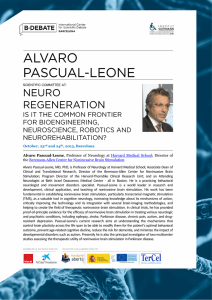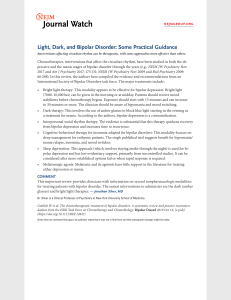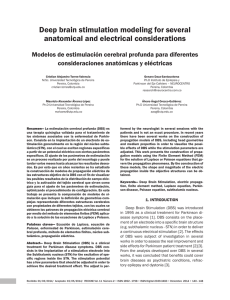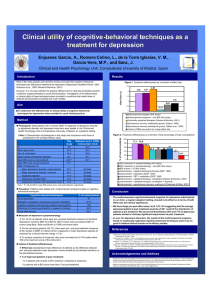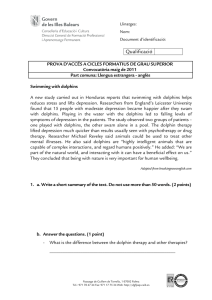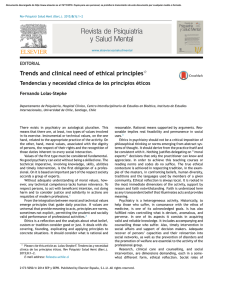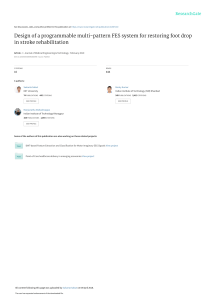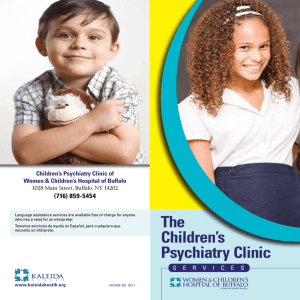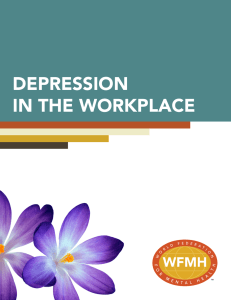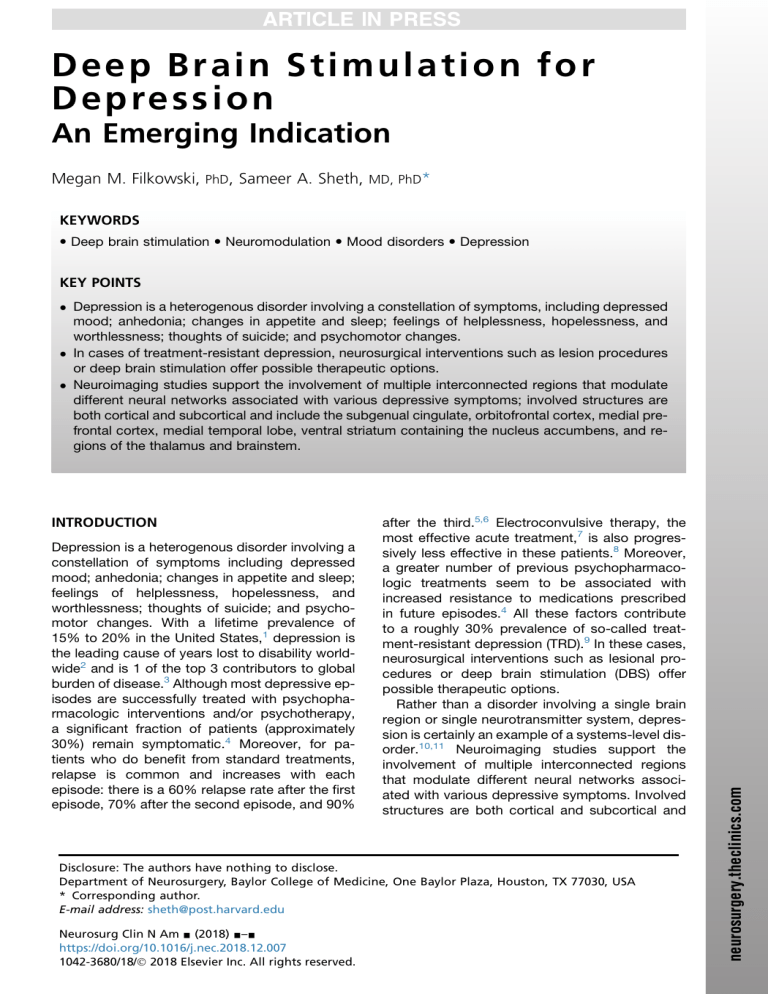
Deep Brain Stimu lat io n f or D e p re s s i o n An Emerging Indication Megan M. Filkowski, PhD, Sameer A. Sheth, MD, PhD* KEYWORDS Deep brain stimulation Neuromodulation Mood disorders Depression KEY POINTS INTRODUCTION Depression is a heterogenous disorder involving a constellation of symptoms including depressed mood; anhedonia; changes in appetite and sleep; feelings of helplessness, hopelessness, and worthlessness; thoughts of suicide; and psychomotor changes. With a lifetime prevalence of 15% to 20% in the United States,1 depression is the leading cause of years lost to disability worldwide2 and is 1 of the top 3 contributors to global burden of disease.3 Although most depressive episodes are successfully treated with psychopharmacologic interventions and/or psychotherapy, a significant fraction of patients (approximately 30%) remain symptomatic.4 Moreover, for patients who do benefit from standard treatments, relapse is common and increases with each episode: there is a 60% relapse rate after the first episode, 70% after the second episode, and 90% after the third.5,6 Electroconvulsive therapy, the most effective acute treatment,7 is also progressively less effective in these patients.8 Moreover, a greater number of previous psychopharmacologic treatments seem to be associated with increased resistance to medications prescribed in future episodes.4 All these factors contribute to a roughly 30% prevalence of so-called treatment-resistant depression (TRD).9 In these cases, neurosurgical interventions such as lesional procedures or deep brain stimulation (DBS) offer possible therapeutic options. Rather than a disorder involving a single brain region or single neurotransmitter system, depression is certainly an example of a systems-level disorder.10,11 Neuroimaging studies support the involvement of multiple interconnected regions that modulate different neural networks associated with various depressive symptoms. Involved structures are both cortical and subcortical and Disclosure: The authors have nothing to disclose. Department of Neurosurgery, Baylor College of Medicine, One Baylor Plaza, Houston, TX 77030, USA * Corresponding author. E-mail address: [email protected] Neurosurg Clin N Am - (2018) -–https://doi.org/10.1016/j.nec.2018.12.007 1042-3680/18/Ó 2018 Elsevier Inc. All rights reserved. neurosurgery.theclinics.com Depression is a heterogenous disorder involving a constellation of symptoms, including depressed mood; anhedonia; changes in appetite and sleep; feelings of helplessness, hopelessness, and worthlessness; thoughts of suicide; and psychomotor changes. In cases of treatment-resistant depression, neurosurgical interventions such as lesion procedures or deep brain stimulation offer possible therapeutic options. Neuroimaging studies support the involvement of multiple interconnected regions that modulate different neural networks associated with various depressive symptoms; involved structures are both cortical and subcortical and include the subgenual cingulate, orbitofrontal cortex, medial prefrontal cortex, medial temporal lobe, ventral striatum containing the nucleus accumbens, and regions of the thalamus and brainstem. 2 Filkowski & Sheth include the subgenual cingulate (SgC), orbitofrontal cortex, medial prefrontal cortex (mPFC), medial temporal lobe, ventral striatum (VS) containing the nucleus accumbens (NaC), and regions of thalamus and brainstem.10,12 Noninvasive neuromodulatory treatments such as transcranial magnetic stimulation or transcranial direct current stimulation have also shown promise, but these treatments are limited by poor targeting precision, especially to deeper subcortical structures, and stimulation cannot be delivered continuously. Herein, we review neurosurgical interventions for TRD, focusing on the recent advancements and future directions of DBS. DBS evolved out of the experience of treating movement disorders (such as Parkinson’s disease, essential tremor) with lesion procedures. The success of DBS for movement disorders led to its application for psychiatric disorders in the late 1990s.19 Several DBS targets have been tested for the treatment of TRD including the ventral capsule (VC)/VS, NaC, SgC, superolateral branch of the medial forebrain bundle (slMFB), and lateral habenula (LHb; Table 1). Historical Development of Neurosurgery for Treatment-Resistant Depression The antidepressant effect of neurosurgical procedures in the VC/VS region has been recognized for both capsulotomy, as described elsewhere int his article, as well as for DBS. VC/VS DBS was initially developed for OCD in the late 1990s given the positive capsulotomy experience.20 A subsequent multiinstitutional study refined the implantation site to its current location near the junction of the anterior limb of the internal capsule, anterior commissure, and posterior VS.21 As with capsulotomy, patients receiving VC/VS stimulation also reported alleviation of depressive symptoms, often occurring before a decrease in OCD symptoms.21,22 OCD and depression are theorized to involve overlapping networks, and imaging studies suggest that VC/VS DBS engages a widespread frontolimbic network, engaging multiple regions involved in depressive symptomology, including other regions that have also been targeted for DBS (NaC and SgC).23–25 These initial reports of reduced depressive symptoms in OCD patients paved the way for the application of VC/VS DBS for TRD.25 The first open-label trial of VC/VS DBS for TRD reported by Malone and colleagues26 in 2009 reported promising results. The chosen VC/VS target was 1 to 2 mm anterior to the posterior border of the anterior commissure and 3 to 4 mm inferior to the anterior commissure–posterior commissure line, based on prior DBS for OCD work. Using the Hamilton Depression Rating Scale (HDRS) as the primary outcome measure, response rates (a 50% decrease in HDRS) were reported as 46.7%, 40%, and 53.3% at 3 months, 6 months, and last follow-up, respectively (Fig. 1). Remission rates (HDRS of <10) were also significant, with 20% of patients achieving remission at 3 and 6 months and 40% in remission at last follow-up.26 The impressive response rate in such refractory patients prompted initiation of an industry-sponsored randomized clinical trial (RCT).27 Neurosurgical ablative procedures have been used for decades to treat a variety of psychiatric disorders. Indeed, the first neurosurgical stereotactic procedures were developed for psychiatric/behavioral indications. The medial thalamotomy, performed by Spiegel and Wycis in the late 1940s, was used to treat “emotional reactivity.”13 Additional stereotactic procedures were developed during the latter half of the 20th century for various psychiatric disorders as well as pain and movement disorders. Ablative procedures in use today, namely, the anterior capsulotomy, dorsal anterior cingulotomy, subcaudate tractotomy, and limbic leucotomy, aim to disrupt white matter tracts between prefrontal cortical regions and subcortical regions of the basal ganglia and thalamus. These procedures can be performed using radiofrequency techniques, stereotactic radiosurgery, laser interstitial thermal therapy, or high-intensity focused ultrasound, and have been successfully used to treat TRD, obsessive– compulsive disorder (OCD), and other psychiatric disorders. Success and use of ablative treatments opened the door for further neurosurgical/stereotactic intervention in psychiatric disorders and allowed for better understanding of the circuitry involved in depression. Efficacy of ablative treatments for depression is suggested to be due to the targeting of connections in the corticostriatothalamocortical network,14 which includes the orbitofrontal cortex, cingulate cortex, mPFC, mediodorsal thalamus, and basal ganglia.15 Although sham-controlled randomized trials have not been performed with these methods, results from open-label series have shown a roughly 40% to 50% response rate for TRD.3,16–18 These response rates are notable given the level of treatment resistance in these patients. VENTRAL CAPSULE AND VENTRAL STRIATUM TARGET Table 1 Demographic and outcomes from various DBS targets Response (%)/Remission (%) Study, Year 39 Age (mean ± SD) Outcome Measure 1 mo 3 mo 6 mo 12 mo Last Follow-Up SgC SgC SgC SgC SgC SgC SgC SgC SgC VC/VS VC/VS VC/VS slMFB slMFB 46 8 47.4 10.4 47.3 6.1 42.0 8.9 47.4 11.3 50.7 9.2 50.3 4.2 50.3 9.7 48.7 10.1 46.3 10.8 47.7 12.0 53.2 8.4 42.6 9.8 43.6 8.9 83/N/A N/A N/A N/A N/A N/A 0/0 12/2 27/0 27/20 20/N/Ab N/A 85/N/A N/A 66/N/A 60/35 48/N/A 41/18 87.5/37.5 33/33 33/0 22/10 55/18 20/20 N/A N/A 100/N/A 50/40 N/A 55/35 29/N/A 36/36 62.5/50 N/A N/A 30/18 45/36 20/7 20/13 40/20 75/50 N/A N/A N/A N/A 92/58 N/A 33/33 N/A 48/25 N/A 20/40 23.3/20 N/A 85/57c N/A 6 20 21 17 8 6 4 60a 11 15 15 25 7/8 4 HDRS-17 HDRS-17 HDRS-17 HDRS-17 HDRS-17 HDRS-24 HDRS-17 MADRS HDRS17 HDRS-24 MADRS HDRS-17 MADRS MADRS 33/N/A 35/10 57/N/A N/A 37.5/0 N/A 17/0 N/A 9/9 20/7 N/A N/A 71/N/A N/A Abbreviations: DBS, deep brain stimulation; HDRS, hamilton depression rating scale (17 item or 24 item); MADRS, montgomery-asberg depression rating scale; N/A, not applicable; SD, standard deviation; SgC, subgenual cingulate; slMFB, supralateral branch of the medial forebrain bundle; VC/VS, ventral capsule/ventral striatum. a Number of patients receiving active stimulation. b Measurement at 4 months. c Measurement at 33 weeks. Deep Brain Stimulation for Depression Mayberg et al, 2005 Lozano et al,41 2008 Lozano et al,42 2012 Holtzheimer et al,29 2012 Puigdemont et al,43 2012 Merkl et al,77 2013 Ramasubbu et al,73 2013 Holtzheimer et al,45 2017 Riva-Posse et al,49 2018 Malone et al,26 2009 Dougherty et al,27 2015 Bergfeld et al,28 2016 Schlaepfer et al,57 2013; Bewernick et al,58 2017 Fenoy et al,59 2016 Target N 3 4 Filkowski & Sheth Fig. 1. Change in the MontgomeryAsberg Depression Rating Scale (MADDRS) and Hamilton Depression Rating Scale (HDRS) over 6 months in responders versus nonresponders. (From Malone DA Jr, Dougherty DD, Rezai AR, et al. Deep brain stimulation of the ventral capsule/ventral striatum for treatment-resistant depression. Biol Psychiatry 2009;65(4):270; with permission.) The RECLAIM trial, sponsored by Medtronic, was a multiinstituional US RCT.27 In this doubleblind, sham-controlled, randomized trial, patients received sham versus active stimulation for 16 weeks followed by an open-label period for up to 2 years. Stimulation parameters were initially optimized for settings that induced acute effects during testing, and the primary end point was a 50% decrease in the Montgomery-Asberg Depression Rating Scale (MADRS). In contrast with expectations from the previous open-label study, no significant difference in response rates were found between patients receiving active (20%) versus sham (14%) stimulation. The study was designed and powered to enroll a total of 208 patients; however, an interim analysis was performed by the sponsor after a total of 30 patients had enrolled. Although this interim analysis was not sufficiently powered to detect a difference between groups at only 30 participants, the findings resulted in the sponsor halting the study early. During the open-label portion of the trial, 20% to 27% of patients achieved response at some point during the 2-year follow-up phase. A subsequent analysis of this study has suggested that the lack of difference between the active and sham stimulation could be a result of several aspects of study design. First, stimulation parameters during the blinded phase were restricted to a specified range and changed only in a prescribed fashion. Therefore, patients receiving active stimulation may not necessarily have received optimized therapy. This fact, however, does not explain the lower response rate during the open-label phase. Second, the implantation site of the electrodes was based off of anatomic locations. Recent tractography research suggests that the optimal target location may need to be adjusted for each patient given interindividual variations in anatomy. It is, therefore, feasible that the electrodes were not optimally placed to engage the fiber pathways and network regions necessary to induce antidepressant effects.27 A nearly contemporaneous RCT from the Netherlands reported different results. The 25 patients in this trial were enrolled using a different trial structure. They initially received an average of 12 months of open-label VC/VS stimulation. During this time, stimulation parameters were optimized until patients exhibited a stable response for 4 weeks or reached the end of the phase. After this time, patients entered a double-blind randomized cross-over phase of either discontinuation of therapy or continued active stimulation. The open-label phase resulted in 40% full response, 20% partial response, and 20% remission rates. Notably, during the blinded cross-over phase, discontinuation of therapy resulted in recurrence of symptoms, whereas continued stimulation did not, demonstrating that DBS therapy was responsible for the observed antidepressant effect. This trial provided Level 1 evidence for the efficacy of VC/VS DBS for TRD.28 The reasons why this trial succeeded and RECLAIM “failed” could be due to several factors. First, slight differences in surgical targeting may have resulted in stimulation and activation of the necessary fiber pathways not engaged in the RECLAIM trial. Second, in RECLAIM, the investigators were unable to fully explore varying Deep Brain Stimulation for Depression combinations of stimulation parameters because of the strict trial regulations. In contrast, Bergfeld and colleagues28 initially treated all patients with open-label active stimulation, allowing investigators more leeway to test various parameters according to their best clinical judgment. Furthermore, the extended optimization phase presumably allowed acute implantation or placebo effects to wear off. Up-front randomization to active versus sham stimulation, as in RECLAIM, would have been subject to both of these early effects.29 VC/VS DBS remains investigational, but recent evidence has shown promise in the form of Level 1 evidence from a single-institution trial. We have learned that issues related to surgical targeting and stimulation parameter exploration are essential to positive outcomes. Details of trial design, including the use of an initial open-label phase, may also play a significant role.28 Stimulationrelated adverse effects of DBS in this region include incidences of hypomania (up to 50% over the course of treatment),30 even in patients without bipolar disorder or prior drug-induced manic/hypomanic symptoms.30 This adverse event usually responds to programming adjustments, but patients must be monitored carefully given the possibility of hypomania-induced deleterious behaviors. TARGETING THE SUBGENUAL CINGULATE CORTEX The SgC, also called Brodmann area 25, is another widely studied target for DBS for TRD. Stimulation of this region, particularly the SgC white matter, is thought to affect a widespread network of regions implicated in depression pathology.31 The SgC is a highly interconnected region that acts as a hub between cortical and subcortical regions with reciprocal pathways to the mPFC, mesial temporal regions, cingulate cortex, insula, brainstem, and hypothalamus.14 Initial work using PET demonstrated increased SgC blood flow in depressed patients and decreased flow with antidepressant treatment.32–34 Furthermore, the decrease in SgC hypermetabolism was sustained in fully remitted patients prescribed maintenance treatment with selective serotonin reuptake inhibitors.35 Studies incorporating mood induction paradigms with healthy controls also suggest that transient normal sadness increases metabolism in SgC, mimicking results observed in depressed patients, which suggests that the SgC is associated with sadness in particular.36–38 This region was, therefore, suggested as a possible DBS target with the goal of downregulating activity to ameliorate depressive symptoms. In an initial open-label trial performed in Toronto,39 6 patients with TRD received bilateral SgC DBS. At the 6-month end point, 4 of the 6 patients (67%) exhibited antidepressant response (50% reduction in HDRS score), and 3 of the 6 were in remission (HRDS of <7).39 Long-term results (2–6 years) were also encouraging, with roughly a 62.5% response at 1 year, 46.2% at 2 years, 75% at 3 years, and 64.3% at the last follow-up.40 In a follow-up study adding another 14 patients to the original cohort of 6 (N 5 20), Lozano and colleagues41 in 2008 (Fig. 2) reported response/remission rates of 35% and 10% at 1 month and 60% and 35% at 6 months, with a sustained benefit through l2 months. Additional open-label studies were conducted with positive results. In a multicenter trial, Lozano and colleagues42 implanted DBS systems in 21 patients and reported response rates of 57% at 1 month, 48% at 6 months, 29% at 12 months, and 62% at last follow-up. Puigdemont and colleagues43 conducted a separate open-label study in 8 patients and reported response/remission rates of 87.5% and 37.5% at 6 months and 62.5% and Fig. 2. Patients meeting response of remission criteria after deep brain stimulation (DBS). The proportion of patients responding or reaching submission increased over time to plateau from 6 to 12 months. (From Lozano AM, Mayberg HS, Giacobbe P, et al. Subcallosal cingulate gyrus deep brain stimulation for treatment-resistant depression. Biol Psychiatry 2008;64(6):463; with permission.) 5 6 Filkowski & Sheth 50.0% at 1 year, respectively. Responses were variable across centers, but the overall encouraging results led to attempts at controlled trials. In the first sham-controlled trial,29 17 unipolar and bipolar type II patients first received singleblind sham stimulation for 1 month followed by active stimulation for 6 months. After the primary end point (6 months), patients then entered a single-blind discontinuation phase. Results from the initial single-blind sham phase of the study showed a significant decrease in HDRS scores between the preoperative baseline and immediate postoperative period, but no significant difference from the postoperative period to the end of sham. These results suggest an implant effect, perhaps owing to microlesion effect or carryover effect from intraoperative stimulation, but only a modest placebo effect from sham stimulation. Active stimulation was associated with response/remission rates of 41% and 18%, respectively, at 6 months, 36% and 36% at 1 year, and 92% and 58% at 2 years. In the 3 patients who received singleblind discontinuation, depressive symptoms increased over a 2-week period. Upon reinitiation of stimulation, symptoms improved, albeit more gradually than the initial improvement. This pattern further suggests therapeutic efficacy of stimulation. Owing to the distress and increase in suicidal ideation associated with discontinuation, however, this phase was halted after the third patient. Importantly, there were no instances of mania or hypomania in either the group with major depressive disorder or the group with bipolar type II.29 Puigdemont and colleagues44 investigated the potential for relapse in a double-blind, crossover study of 5 remitted patients who received SgC DBS. At the end of the active stimulation phase, 4 of 5 patients remained in remission. When crossed to the sham phase, 2 patients remained in remission, 2 relapsed, and 1 exhibited worsening symptoms that did not meet the criteria for relapse, highlighting both efficacy and the need for chronic stimulation in SgC TRD. Based on the promising results from all these studies, a large multiinstitutional RTC was conducted. The BROADEN trial was an industry-sponsored, multisite, double-blind, sham-controlled RTC funded by St. Jude Neuromodulation, now Abbott. After implantation, patients were randomly assigned to 6 months of active treatment or sham stimulation followed by 6 months of openlabel stimulation.45 The primary end point was a 50% decrease in MADRS scores at the end of the blinded phase. The study was powered with the expectation of a 40% true response rate, and up to an 18.5% sham response rate, with a total of 201 patients to be enrolled. A planned interim analysis was performed after the first 90 patients had completed the 6-month sham-controlled phase, at which point they observed a 20% response in the active group and a 17% response rate in the sham group. An ensuing futility analysis suggested that there was a 17% chance that continuing the study would result in a significant difference between groups. Although the futility analysis did not meet the preset threshold (<10% chance) to end the study, the sponsor chose to close enrollment.45 The results of the BROADEN trial and the number of nonresponders in prior trials highlighted the need to more carefully investigate factors affecting the efficacy of SgC DBS therapy. A number of factors have been discussed, including patient selection, surgical targeting, trial design, stimulation parameter exploration, and several others, as discussed elsewhere in this article.46 A key factor influencing successful SgC DBS that has emerged over the past several years is surgical targeting. Hamani and colleagues47 compared electrode placement between responders and nonresponders and reported no differences in the anatomic location of the electrodes between the 2 groups in terms of simple x–y–z coordinates. However, another hypothesis proposes that the targeting of specific white matter tracts on an individualized basis, rather than “one size fits all” canonical coordinates, may improve outcomes. Retrospective data consistent with this theory came from Riva-Posse and colleagues,48 who obtained preoperative diffusion tensor imaging data from 16 SgC DBS patients (Fig. 3). Whole brain probabilistic tractography showed white matter tract convergence in all patients who responded to DBS at both 6 months and 2 years. These patients shared bilateral white matter pathways including forceps minor and uncinate fasciculus, cingulum bundle, and frontostriatal fibers.48 In addition, as in the study by Hamani and colleagues,47 the x–y–z coordinates of active contacts did not distinguish responders and nonresponders. Using this targeting heuristic, a subsequent study tested the use of prospective white matter tracking to guide targeting.49 Preoperative deterministic tractography was used to identify the implantation site in 11 patients. Active contacts were determined by combining the deterministic tractography with postoperative probabilistic tractography in each individual patient. All patients received open-label stimulation. At the end of 6 months, 72.7% of patients responded and, of those, 5 of the 11 achieved remission. By the end of 12 months, 81.8% responded with 5 Deep Brain Stimulation for Depression Fig. 3. Diffusion tensor imaging-based patient individual planning of bilateral superolateral medial forebrain bundle (slMFB) deep brain stimulation (DBS). (A–C) Projection of the S1MFB (dark green, left side) onto sagittal (A), axial (B), and coronal (C) sections. Note bilateral deep brain stimulation (DBS) electrode positions in B (white circles). (D) Three-dimensional rendering as seen from posterior and superior left includes final DBS electrode positions (white rods). VTA, ventral tegmental area. (From Schlaepfer TE, Bewernick BH, Kayser S, et al. Rapid effects of deep brain stimulation for treatment-resistant major depression. Biol Psychiatry 2013;73(12):1207; with permission.) achieving remission (Fig. 4).49 Findings from this study are encouraging and suggest that stimulation of specific white matter pathways is pivotal to positive outcomes in SgC DBS. In addition, using diffusion tensor imaging tractography can enable patient-specific targeting to ensure stimulation of those pathways. TARGETING THE SUPEROLATERAL BRANCH OF THE MEDIAL FOREBRAIN BUNDLE Reward network dysfunction in depression is widely reported.50–53 This network includes the NaC, ventral tegmental area, amygdala, and several nuclei of the hypothalamus connected via the medial forebrain bundle.54,55 Similar to the hypermetabolism reported in the SgC neuroimaging, studies report an association of depression with dysfunction in the reward network.51,56 These circuit-based arguments led to the hypothesis that stimulation of the medial forebrain bundle would modulate a dysfunctional reward network and engage motivational behavior to alleviate anhedonia in patients with TRD. The slMFB, in particular, was chosen as a possible target for DBS owing to its proximity to the ventral tegmental area and structural and functional connectivity to other DBS targets. The first open-label pilot study of slMFB DBS reported encouraging results.57 Because the slMFB is not readily seen on conventional MRI, 7 patients with TRD were implanted using deterministic tractography to locate the slMFB. Use of tractography-guided implantation also reduces the likelihood of stimulating nearby oculomotor nerve fibers and causing dose-limiting side effects. The effects of stimulation were rapid, with 4 of 7 patients (57%) responding at 1 week and 5 of 7 patients (71%) responding at 6 weeks (Fig. 5). At last follow-up, all but 1 patient reached 7 8 Filkowski & Sheth Fig. 4. Whole brain probabilistic tractography of shared fiber tract maps of subcallosal cingulate deep brain stimulation target. (Left) Six-month responders (resp.; n 5 6). (Middle) Six-month nonresponders (non-resp.; n 5 10). (Right) Two-year responders (n 5 12). Responders (at 6 months and 2 years) noted in blue. Nonresponders (at 6 months) noted in green. Based on individual activation volume tract maps, all 6-month responders share bilateral pathways via forceps minor and uncinate fasciculus to medial frontal cortex (Brodmann area 10); via the cingulum bundle to subgenual, rostral, and dorsal anterior and midcingulate; and descending subcortical fibers to ventral striatum (NaC, ventral pallidum), putamen, hypothalamus, and anterior thalamus. Six-month nonresponders, although similar in some regions, lack connections to both medial frontal and subcortical regions seen in the responder group. All 2-year responders show a pattern that is nearly identical to the 6-month responder tract map. ACC, anterior cingulate cortex; L, left; mF, medial frontal; P, putamen; R, right; Th, thalamus; vSt, ventral striatum. (From Riva-Posse P, Choi KS, Holtzheimer PE, et al. Defining critical white matter pathways mediating successful subcallosal cingulate deep brain stimulation for treatment-resistant depression. Biol Psychiatry 2014;76(12):966; with permission.) response criterion (86%), and 4 had achieved remission.57 A long-term follow-up study of the same patients reported 6 of 8 patients (75%) as responders and 4 patients (50%) in remission, with stable effects for up to 4 years.58 Fenoy and colleagues59 reported interim findings on 4 patients enrolled in a larger single-blind sham-controlled clinical trial assessing the safety and efficacy of slMFB DBS. After implantation, patients entered the sham-controlled phase for 1 month followed by active stimulation for 1 year. At the end of the sham-controlled phase, all patients exhibited a decrease in depressive symptoms, but the difference between baseline and the end of the sham phase was not significant. After 1 week of stimulation, patients exhibited a further and significant decrease in MADRS scores, with 3 of 4 patients classified as responders. One patient who completed 52 weeks by the time of the report had achieved an 85% decrease in depressive symptoms.59 A subsequent study from the same group described results in 2 additional patients, with longer follow-up of the cohort.60 With the inclusion of 2 more patients, the decrease in MADRS between preoperative baseline and the end of the sham period (28% decrease; P 5 .02) was significant. With active stimulation, MADRS scores further improved, with a mean response rate of 3 of 6 after 1 week of stimulation, and 4 of 5 (1 patient dropped out) after 52 weeks. For patients with TRD, the slMFB seems to be a promising DBS target. The white matter tracts and prefrontal cortical targets to which they project are likely shared between this target and the ones previously discussed.61 The proximity of other brainstem structures in the area, in particular the oculomotor fibers, can produce dose-limiting side effects. Future work with this target will need to incorporate sham and blinding strategies Deep Brain Stimulation for Depression Fig. 5. Blueprint used for structural connectivity-based target selection. (A) The necessary 4 fiber bundles, namely forceps minor, uncinate fasciculus, cingulum bundle and fronto-striatal fibers, based on the common fibers impacted by DBS responders in Holtzheimer and colleagues29 (2012). (B) An individualized deterministic tractography target selection in 1 participant: optimal target location within SCC region with modeled stimulation impacting necessary fiber bundles for effective SCC DBS. CB, Cingulum Bundle; DBS, deep brain stimulation; FM, forceps minor; F-St, fronto-striatal fibers; SCC, subcallosal cingulate; UF, uncinate fasciculus. (From Riva-Posse P, Choi K, Holtzheimer PE, et al. A connectomic approach for subcallosal cingulate deep brain stimulation surgery: prospective targeting in treatment-resistant depression. Mol Psychiatry 2018;23(4):843; with permission.) to disentangle insertion, sham response, and other such effects from true response. TARGETING THE LATERAL HABENULA Catecholamines, specifically serotonin and norepinephrine, are hypothesized to play a significant role in the pathogenesis of depression.62,63 The LHb is a small structure that modulates the dorsal raphe nucleus and locus coeruleus, regions from which serotonin fibers originate.64,65 The dorsal raphe nucleus and locus ceruleus in turn project serotonin fibers to the mPFC, which also modulates activity of both regions.66,67 One hypothesis proposes that increased activity within the LHb downregulates catelcholaminergic pathways between this network of structures resulting in depressive symptoms.68 Both animal and human research has implicated the habenula in both reward network dysfunction and negative mood states. Recent irreversible learned helplessness animal models of depression69 have provided fundamental understanding of the role of the LHb in regulating behaviors possibly related to mood.70 In humans, depletion of the serotonin precursor tryptophan results in an increase in both LHb cerebral blood flow and depressive mood symptoms, further supporting the involvement of the region in human depression.71 LHb inhibition with DBS has therefore been proposed as an antidepressant strategy. In a case report describing the use of bilateral LHb DBS in a 65-year-old patient with TRD, stimulation of the LHb resulted in full remission after 4 months of treatment. The patient did relapse upon accidental discontinuation of stimulation, but symptoms resolved upon resumed stimulation, suggesting that benefit was not due to placebo effects.72 The animal literature and the previously described case report spurred the initiation of the first open-label pilot trial that is currently underway to evaluate the safety and potential efficacy of bilateral DBS in LHb (NCT01798407). LESSONS LEARNED FROM PREVIOUS TRIALS The insignificant difference between sham and true response seen in the 2 large RCTs for the VC/VS and SgC targets contrasts with the observation of a significant number of patients who seem to have benefited from DBS therapy in the preceding open-label studies. Discussions involving several leaders in this field have identified a number of possibly contributing factors.46 The first factor could be a true lack of efficacy of the treatment itself. However, data from several studies indicate that patients who have had unexpected battery failures27,29 or were part of a blinded discontinuation after achieving response28,44 experienced either a significant decline in mood or relapsed, which indicates that the device likely was providing an antidepressant effect. The response rates could be due to a placebo effect. Roughly 14% to 17% of patients are placebo responders as reported by RECLAIM and BROADEN, which may indicate that some patients may simply derive benefit from the intensive care received from their treatment teams. A placebo effect would indeed obfuscate differences between active and sham stimulation, especially in trials 9 10 Filkowski & Sheth with upfront randomization between the 2 groups. In addition to this effect, outcomes in the larger RCTs could be due to several issues including study design, patient selection, and targeting and stimulation optimization, as discussed elsewhere in this article. Trial Design Trial design strategy may play a significant role in the differences reported in response rates. First, some previous trials have relied on designs in which patients are randomized to sham or active stimulation with a primary end point of 3 to 6 months, which is relatively short compared with the 12- to 24-month end points in many open-label trials. In the most studied targets, the VC/VS and SgC, response can take several months to achieve. If the full effect of DBS requires more time, assessing outcomes at 3 or 6 months would not adequately capture true response rates. When up against a sham response rate of perhaps 15% to 20%, a short time window may not provide enough time for the curves to diverge. In the BROADEN study, for example, the initial interim analysis was performed with 90 participants who completed the 6-month blinded phase and found only a 20% response rate, but after 24 months with open-label stimulation, the response rate increased to 49%. Second, increased time and flexibility for optimization of stimulation parameters may be needed before assessing primary end points. Both BROADEN and RECLAIM imposed strict limitations on parameter adjustments during the blinded phase of the study and reported increased response rates during the open-label portion when parameters could be manipulated fully. Ramasubbu and colleagues73 also strictly controlled stimulation parameters, even when the current settings were ineffective. Importantly, at the end of that study, stimulation parameters were changed in a nonresponder and resulted in a 30% decrease in HDRS score in 1 month. The stimulation parameters typically used for TRD are derived from the movement disorder experience and therefore may not be optimal. Tight adherence to this narrow range of parameter space may not be ideal for TRD trials. Another option following the design of the study from Bergfeld and colleagues28 is the incorporation of an upfront extended open-label period during which stimulation parameters are individually optimized for each patient. In that trial, patients were then cross-over randomized to discontinuation or continued stimulation to assess the efficacy of stimulation. Other design options include device implantation on a staggered or waitlisted fashion or a stepped-wedge design during which patients receive treatment at different times allowing for between-participant analysis. Patient Selection Patient selection in psychiatric clinical trials, especially DBS trials, is notoriously difficult.74 Depression is a heterogenous disorder characterized by a multitude of possible symptoms and combinations thereof. Patients with 1 constellation of symptoms may be better suited for 1 target over another. Knowing which symptoms are ameliorated by each target location could help to tailor treatment to patients with a specific set of symptoms. Further research is also needed to investigate possible biomarkers that may identify patients who may be more likely to respond to DBS. As an analogy, restricting DBS implants to Parkinson’s disease patients who are levodopa responsive results in a much better overall response rate than including all patients. Clinical trials generally incorporate strict inclusion and exclusion criteria to create a homogeneous sample, but as a result may exclude those who would have benefitted and, in real-world practice, comorbidities are the rule rather than the exception. TRD may mask underlying pathology, which may only surface when depressive symptoms regress. Recently, the National Institutes of Health has proposed a new transdiagnostic system design called the Research Domain Criteria to organize symptoms into functional domains. By focusing not only on behaviors and thought patterns, but also on neurobiology and genetics, the Research Domain Criteria approach aims to link functional domains with known neural circuitry that ideally can, in turn, be treated with more rationally designed treatments.75 The implementation of Research Domain Criteria concepts into patient selection may help to better match patients with disorders such as depression with the most appropriate treatment. Targeting The 2 unsuccessful pivotal trials were conducted quickly and before sufficient research had been conducted to perfect targeting and dosing optimization procedures. The RECLAIM trial was initiated after only 1 multiinstitutional open-label trial. Shortly after initiation of the BROADEN study, the benefit of individualized white matter targeting began to be appreciated,49 but the technique could not be incorporated into the trial. A similar tractographic analysis has not yet been published for the VC/VS target. Before the initiation of large Deep Brain Stimulation for Depression trials, more investigation regarding the neural pathways involved in each target location and the symptoms associated with those pathways needs to be conducted. methods, the study hopes to gain insight into the networks underlying depression symptomatology, investigate the ability to predict the effects of DBS on network activity, and combine results to implement a network-guided approach for DBS for TRD. FUTURE DIRECTIONS From the trials discussed, it is clear that there are gaps in our knowledge that result in inconclusive results on the effectiveness of DBS for TRD. These gaps include a (1) lack of a comprehensive understanding of the brain networks involved in TRD both in general and specifically within an individual and (2) the present inability to adequately target and confirm engagement of these networks with current DBS technology. Ongoing efforts are bringing new technologies to bear on this yet investigational but promising therapy, including closed-loop approaches and individualized network targeting with intracranial recording. Closed-Loop Approach The closed-loop approach intends to investigate neural networks engaged by DBS using a system designed to both stimulate and record from the DBS lead.76 A currently funded trail (NCT01984710) is using an experimental prototype DBS system that has this ability to both stimulate and chronically record local field potential data. These recordings can be wirelessly downloaded from the implanted device. This device may be a powerful research tool that can facilitate investigation of the neuronal changes associated with antidepressant response to chronic DBS. This study has the potential to provide insight into the fundamental neuronal processes that underlie depressive illness and antidepressant response. Directional Current and Intracranial Recording Approach Another recently initiated trial (NCT03437928) is using intracranial recordings to understand network physiology at the individual level, and a DBS system with directional steering that will allow specific targeting of the identified optimal subnetwork. Unlike previous studies, this study will implant at 2 target sites, the VC/VS and the SgC, which involve overlapping but distinct networks and hopefully will thus be able to address a wide range of depressive symptoms.25 Furthermore, this study includes the implantation of intracranial depth electrodes to subchronically monitor neurophysiological changes in response to stimulation and to assist in tailoring stimulation parameters on a participant-by-participant basis. With these SUMMARY Given the prevalence and associated disability burden associated with TRD, new therapies are greatly needed. The initial enthusiasm for DBS was tempered by the 2 halted pivotal trials, but a recent resurgence in promise has been fueled by transdiagnostic approaches to patient evaluation, advances in imaging connectomics, and an increased appreciation of individualized network engagement. Future studies addressing key problems evident in the design and implementation of prior trials will help to disambiguate sham from true response and optimize stimulation parameters. With the recent resurgence in interest in this therapy and an infusion of National Institutes of Health funding through the BRAIN Initiative, the next several years should see significant advances in this therapy. REFERENCES 1. Kessler RC, Berglund P, Demler O, et al. Lifetime prevalence and age-of-onset distributions of DSM-IV disorders in the National Comorbidity Survey Replication. Arch Gen Psychiatry 2005;62(6): 593–602. 2. World Health Organization. Depression and other common mental disorders: global health estimates. Geneva (Switzerland): World Health Organization; 2017. 3. World Health Organization. Global health estimates 2016: deaths by cause, age, sex, by country and by region, 2000-2016. Geneva (Switzerland): World Health Organization; 2016. 4. Rush AJ, Trivedi MH, Wisniewski SR, et al. Acute and longer-term outcomes in depressed outpatients requiring one or several treatment steps: a STAR* D report. Am J Psychiatry 2006;163(11):1905–17. 5. American Psychiatric Association. Diagnostic and statistical manual of mental disorders. 4th edition. Washington, DC: APA press; 2000. 6. Sackeim HA. The definition and meaning of treatment-resistant depression. J Clin Psychiatry 2001;62(Suppl 16):10–7. 7. Carney S, Cowen P, Geddes J, et al. Efficacy and safety of electroconvulsive therapy in depressive disorders: a systematic review and meta-analysis. Lancet 2003;361(9360):799–808. 11 12 Filkowski & Sheth 8. Prudic J, Sackeim HA, Devanand DP. Medication resistance and clinical response to electroconvulsive therapy. Psychiatry Res 1990;31(3):287–96. 9. Nemeroff CB. Prevalence and management of treatment-resistant depression. J Clin Psychiatry 2007;68(8):17. 10. Mayberg HS. Limbic-cortical dysregulation: a proposed model of depression. J Neuropsychiatry Clin Neurosci 1997;9(3):471–81. 11. Nemeroff CB. Recent advances in the neurobiology of depression. Psychopharmacol Bull 2002; 36:6–23. 12. Mayberg HS. Modulating dysfunctional limbiccortical circuits in depression: towards development of brain-based algorithms for diagnosis and optimised treatment. Br Med Bull 2003;65(1):193–207. 13. Spiegel EA, Wycis HT, Marks M, et al. Stereotaxic apparatus for operations on the human brain. Science 1947;106(2754):349–50. 14. Mayberg HS. Targeted electrode-based modulation of neural circuits for depression. J Clin Invest 2009; 119(4):717–25. 15. Rauch SL, Shin LM, Wright CI. Neuroimaging studies of amygdala function in anxiety disorders. Ann N Y Acad Sci 2003;985(1):389–410. 16. Sachdev P, Sachdev J. Sixty years of psychosurgery: its present status and its future. Aust N Z J Psychiatry 1997;31(4):457–64. 17. Christmas D, Eljamel MS, Butler S, et al. Long term outcome of thermal anterior capsulotomy for chronic, treatment refractory depression. J Neurol Neurosurg Psychiatry 2011;82(6):594–600. 18. Shields DC, Asaad W, Eskandar EN, et al. Prospective assessment of stereotactic ablative surgery for intractable major depression. Biol Psychiatry 2008; 64(6):449–54. 19. Gardner J. A history of deep brain stimulation: technological innovation and the role of clinical assessment tools. Soc Stud Sci 2013;43(5):707–28. 20. Nuttin B, Cosyns P, Demeulemeester H, et al. Electrical stimulation in anterior limbs of internal capsules in patients with obsessive-compulsive disorder. Lancet 1999;354(9189):1526. 21. Greenberg B, Gabriels L, Malone D Jr, et al. Deep brain stimulation of the ventral internal capsule/ ventral striatum for obsessive-compulsive disorder: worldwide experience. Mol Psychiatry 2010; 15(1):64. 22. Goodman WK, Foote KD, Greenberg BD, et al. Deep brain stimulation for intractable obsessive compulsive disorder: pilot study using a blinded, staggered-onset design. Biol Psychiatry 2010; 67(6):535–42. 23. Figee M, Luigjes J, Smolders R, et al. Deep brain stimulation restores frontostriatal network activity in obsessive-compulsive disorder. Nat Neurosci 2013; 16(4):386. 24. Haber SN, Heilbronner SR. Translational research in OCD: circuitry and mechanisms. Neuropsychopharmacology 2013;38(1):252. 25. Nanda P, Banks GP, Pathak YJ, et al. Connectivitybased parcellation of the anterior limb of the internal capsule. Hum Brain Mapp 2017;38(12):6107–17. 26. Malone DA Jr, Dougherty DD, Rezai AR, et al. Deep brain stimulation of the ventral capsule/ventral striatum for treatment-resistant depression. Biol Psychiatry 2009;65(4):267–75. 27. Dougherty DD, Rezai AR, Carpenter LL, et al. A randomized sham-controlled trial of deep brain stimulation of the ventral capsule/ventral striatum for chronic treatment-resistant depression. Biol Psychiatry 2015;78(4):240–8. 28. Bergfeld IO, Mantione M, Hoogendoorn ML, et al. Deep brain stimulation of the ventral anterior limb of the internal capsule for treatment-resistant depression: a randomized clinical trial. JAMA Psychiatry 2016;73(5):456–64. 29. Holtzheimer PE, Kelley ME, Gross RE, et al. Subcallosal cingulate deep brain stimulation for treatmentresistant unipolar and bipolar depression. Arch Gen Psychiatry 2012;69(2):150–8. 30. Widge AS, Licon E, Zorowitz S, et al. Predictors of hypomania during ventral capsule/ventral striatum deep brain stimulation. J Neuropsychiatry Clin Neurosci 2016;28(1):38–44. 31. Tsolaki E, Espinoza R, Pouratian N. Using probabilistic tractography to target the subcallosal cingulate cortex in patients with treatment resistant depression. Psychiatry Res Neuroimaging 2017;261:72–4. 32. Mottaghy FM, Keller CE, Gangitano M, et al. Correlation of cerebral blood flow and treatment effects of repetitive transcranial magnetic stimulation in depressed patients. Psychiatry Res Neuroimaging 2002;115(1–2):1–14. 33. Nobler MS, Oquendo MA, Kegeles LS, et al. Decreased regional brain metabolism after ECT. Am J Psychiatry 2001;158(2):305–8. 34. Goodwin G, Austin M-P, Dougall N, et al. State changes in brain activity shown by the uptake of 99mTc-exametazime with single photon emission tomography in major depression before and after treatment. J Affect Disord 1993;29(4):243–53. 35. Liotti M, Mayberg HS, McGinnis S, et al. Unmasking disease-specific cerebral blood flow abnormalities: mood challenge in patients with remitted unipolar depression. Am J Psychiatry 2002;159(11):1830–40. 36. Mayberg HS, Liotti M, Brannan SK, et al. Reciprocal limbic-cortical function and negative mood: converging PET findings in depression and normal sadness. Am J Psychiatry 1999;156(5):675–82. 37. George MS, Ketter TA, Parekh PI, et al. Brain activity during transient sadness and happiness in healthy women. Am J Psychiatry 1995;152(3):341–51. Deep Brain Stimulation for Depression 38. Baker SC, Frith CD, Dolan RJ. The interaction between mood and cognitive function studied with PET. Psychol Med 1997;27(3):565–78. 39. Mayberg HS, Lozano AM, Voon V, et al. Deep brain stimulation for treatment-resistant depression. Neuron 2005;45(5):651–60. 40. Kennedy SH, Giacobbe P, Rizvi SJ, et al. Deep brain stimulation for treatment-resistant depression: follow-up after 3 to 6 years. Am J Psychiatry 2011; 168(5):502–10. 41. Lozano AM, Mayberg HS, Giacobbe P, et al. Subcallosal cingulate gyrus deep brain stimulation for treatment-resistant depression. Biol Psychiatry 2008;64(6):461–7. 42. Lozano AM, Giacobbe P, Hamani C, et al. A multicenter pilot study of subcallosal cingulate area deep brain stimulation for treatment-resistant depression. J Neurosurg 2012;116(2):315–22. 43. Puigdemont D, Pérez-Egea R, Portella MJ, et al. Deep brain stimulation of the subcallosal cingulate gyrus: further evidence in treatment-resistant major depression. Int J Neuropsychopharmacol 2012; 15(1):121–33. 44. Puigdemont D, Portella MJ, Pérez-Egea R, et al. A randomized double-blind crossover trial of deep brain stimulation of the subcallosal cingulate gyrus in patients with treatment-resistant depression: a pilot study of relapse prevention. J Psychiatry Neurosci 2015;40(4):224. 45. Holtzheimer PE, Husain MM, Lisanby SH, et al. Subcallosal cingulate deep brain stimulation for treatment-resistant depression: a multisite, randomised, sham-controlled trial. Lancet Psychiatry 2017;4(11):839–49. 46. Bari AA, Mikell CB, Abosch A, et al. Charting the road forward in psychiatric neurosurgery: proceedings of the 2016 American Society for Stereotactic and Functional Neurosurgery Workshop on Neuromodulation for Psychiatric Disorders. J Neurol Neurosurg Psychiatry 2018;89(8):886–96. 47. Hamani C, Mayberg H, Snyder B, et al. Deep brain stimulation of the subcallosal cingulate gyrus for depression: anatomical location of active contacts in clinical responders and a suggested guideline for targeting. J Neurosurg 2009;111(6): 1209–15. 48. Riva-Posse P, Choi KS, Holtzheimer PE, et al. Defining critical white matter pathways mediating successful subcallosal cingulate deep brain stimulation for treatment-resistant depression. Biol Psychiatry 2014;76(12):963–9. 49. Riva-Posse P, Choi K, Holtzheimer PE, et al. A connectomic approach for subcallosal cingulate deep brain stimulation surgery: prospective targeting in treatment-resistant depression. Mol Psychiatry 2018;23(4):843. 50. Satterthwaite TD, Kable JW, Vandekar L, et al. Common and dissociable dysfunction of the reward system in bipolar and unipolar depression. Neuropsychopharmacology 2015;40(9):2258. 51. Smoski MJ, Rittenberg A, Dichter GS. Major depressive disorder is characterized by greater reward network activation to monetary than pleasant image rewards. Psychiatry Res Neuroimaging 2011;194(3): 263–70. 52. Keedwell PA, Andrew C, Williams SC, et al. A double dissociation of ventromedial prefrontal cortical responses to sad and happy stimuli in depressed and healthy individuals. Biol Psychiatry 2005;58(6): 495–503. 53. Schaefer HS, Putnam KM, Benca RM, et al. Eventrelated functional magnetic resonance imaging measures of neural activity to positive social stimuli in pre- and post-treatment depression. Biol Psychiatry 2006;60(9):974–86. 54. Zellner MR, Watt DF, Solms M, et al. Affective neuroscientific and neuropsychoanalytic approaches to two intractable psychiatric problems: why depression feels so bad and what addicts really want. Neurosci Biobehav Rev 2011;35(9):2000–8. 55. Sesack SR, Grace AA. Cortico-basal ganglia reward network: microcircuitry. Neuropsychopharmacology 2010;35(1):27. 56. Dichter GS, Kozink RV, McClernon FJ, et al. Remitted major depression is characterized by reward network hyperactivation during reward anticipation and hypoactivation during reward outcomes. J Affect Disord 2012;136(3):1126–34. 57. Schlaepfer TE, Bewernick BH, Kayser S, et al. Rapid effects of deep brain stimulation for treatmentresistant major depression. Biol Psychiatry 2013; 73(12):1204–12. 58. Bewernick BH, Kayser S, Gippert SM, et al. Deep brain stimulation to the medial forebrain bundle for depression-long-term outcomes and a novel data analysis strategy. Brain Stimul 2017;10(3): 664–71. 59. Fenoy AJ, Schulz P, Selvaraj S, et al. Deep brain stimulation of the medial forebrain bundle: distinctive responses in resistant depression. J Affect Disord 2016;203:143–51. 60. Fenoy AJ, Schulz PE, Selvaraj S, et al. A longitudinal study on deep brain stimulation of the medial forebrain bundle for treatment-resistant depression. Transl Psychiatry 2018;8(1):111. 61. Coenen VA, Panksepp J, Hurwitz TA, et al. Human medial forebrain bundle (MFB) and anterior thalamic radiation (ATR): imaging of two major subcortical pathways and the dynamic balance of opposite affects in understanding depression. J Neuropsychiatry Clin Neurosci 2012;24(2): 223–36. 13 14 Filkowski & Sheth 62. Grossman F, Potter WZ. Catecholamines in depression: a cumulative study of urinary norepinephrine and its major metabolites in unipolar and bipolar depressed patients versus healthy volunteers at the NIMH. Psychiatry Res 1999;87(1):21–7. 63. Charney DS. Monoamine dysfunction and the pathophysiology and treatment of depression. J Clin Psychiatry 1998;59(Suppl 14):11–4. 64. Herkenham M, Nauta WJ. Efferent connections of the habenular nuclei in the rat. J Comp Neurol 1979;187(1):19–47. 65. Sutherland RJ. The dorsal diencephalic conduction system: a review of the anatomy and functions of the habenular complex. Neurosci Biobehav Rev 1982;6(1):1–13. 66. Celada P, Puig MV, Casanovas JM, et al. Control of dorsal raphe serotonergic neurons by the medial prefrontal cortex: involvement of serotonin-1A, GABAA, and glutamate receptors. J Neurosci 2001; 21(24):9917–29. 67. Condés-Lara M. Different direct pathways of locus coeruleus to medial prefrontal cortex and centrolateral thalamic nucleus: electrical stimulation effects on the evoked responses to nociceptive peripheral stimulation. Eur J Pain 1998;2(1):15–23. 68. Sartorius A, Henn FA. Deep brain stimulation of the lateral habenula in treatment resistant major depression. Med Hypotheses 2007;69(6):1305–8. 69. Vollmayr B, Henn FA. Stress models of depression. Clin Neurosci Res 2003;3(4–5):245–51. 70. Shumake J, Edwards E, Gonzalez-Lima F. Opposite metabolic changes in the habenula and ventral 71. 72. 73. 74. 75. 76. 77. tegmental area of a genetic model of helpless behavior. Brain Res 2003;963(1–2):274–81. Morris J, Smith K, Cowen P, et al. Covariation of activity in habenula and dorsal raphe nuclei following tryptophan depletion. Neuroimage 1999; 10(2):163–72. Sartorius A, Kiening KL, Kirsch P, et al. Remission of major depression under deep brain stimulation of the lateral habenula in a therapy-refractory patient. Biol Psychiatry 2010;67(2):e9–11. Ramasubbu R, Anderson S, Haffenden A, et al. Double-blind optimization of subcallosal cingulate deep brain stimulation for treatment-resistant depression: a pilot study. J Psychiatry Neurosci JPN 2013; 38(5):325. Filkowski MM, Mayberg HS, Holtzheimer PE. Considering eligibility for studies of deep brain stimulation for treatment-resistant depression: insights from a clinical trial in unipolar and bipolar depression. J ECT 2016;32(2):122. Insel T, Cuthbert B, Garvey M, et al. Research domain criteria (RDoC): toward a new classification framework for research on mental disorders. Am J Psychiatry 2010;167(7):748–51. Widge AS, Malone DA Jr, Dougherty DD. Closing the loop on deep brain stimulation for treatmentresistant depression. Front Neurosci 2018;12:175. Merkl A, Schneider GH, Schönecker T, et al. Antidepressant effects after short-term and chronic stimulation of the subgenual cingulate gyrus in treatment-resistant depression. Experimental neurology 2013;249:160–8.
